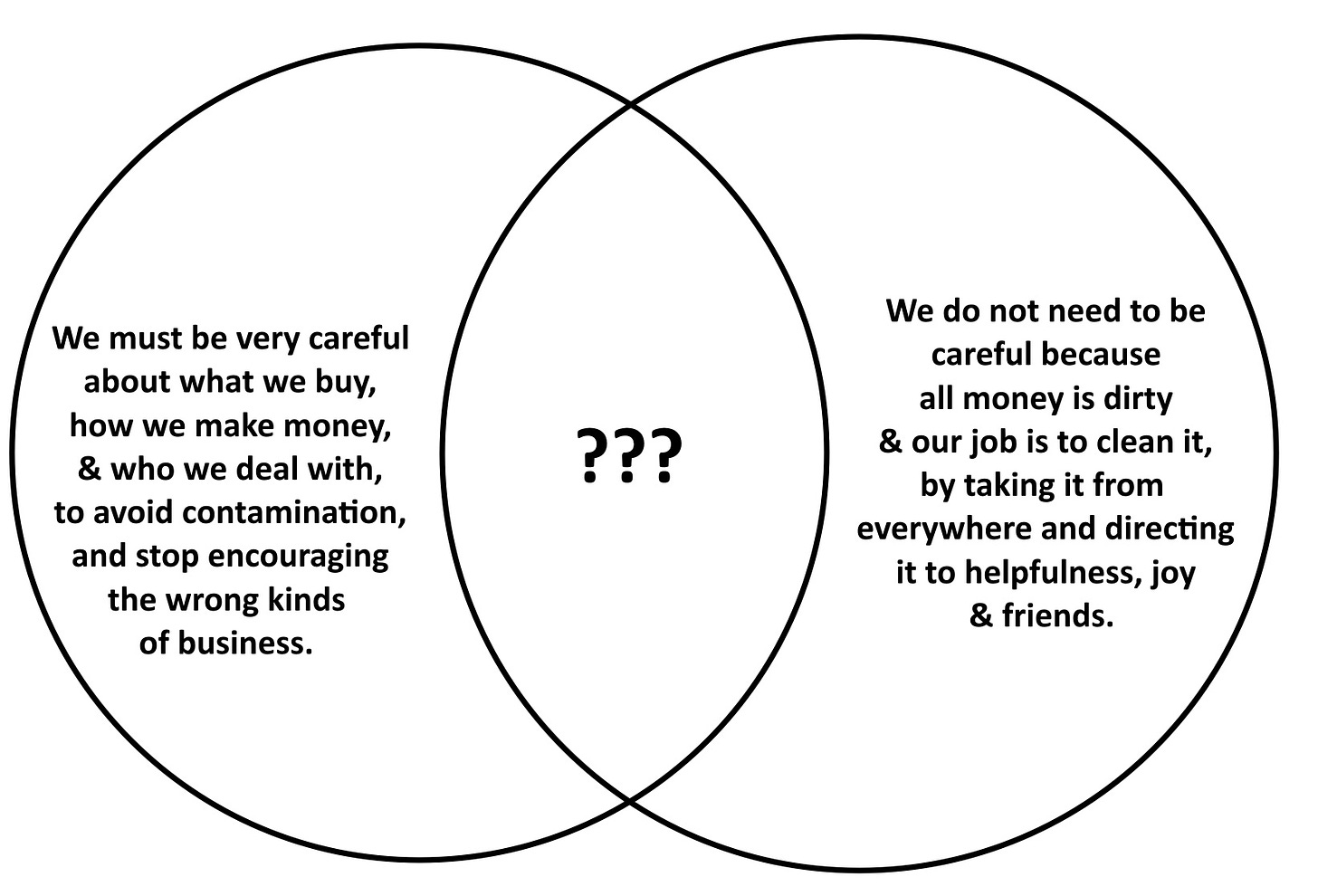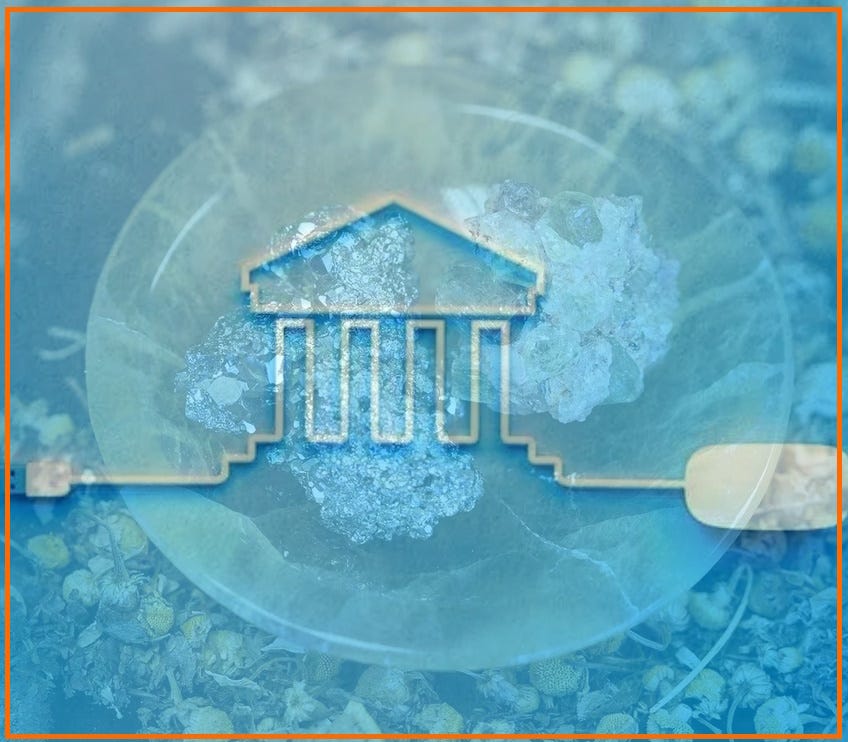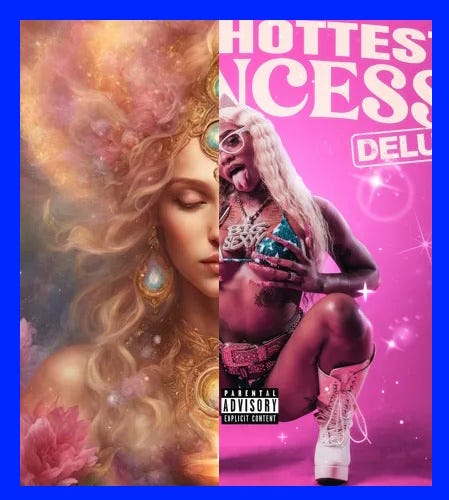Make "Game A" Pay for the Wall !
Further Meditations on the Interior & Exterior of Liminal Economies
(If everything were simply up to me, this article would be about “The Unsurpassable Joy of Making Explicit the Implied Logic of the Deferral of Self-Release from Existential Self-Contraction.” That’s my arcane jam. Fortunately for you, I am currently bowing to the public interest. There was a lot of excitement around my previous popular essay on the Metamodern Business Bureau. As a service to The Field (sic), this is a follow-up article to help perpetuate and extend the energy of our shared discussions on liminal, transitional, and regenerative economics. And, as usual, there is an accompanying audio version for paying subscribers.)
I. Our Wall ?
Money makes the world go ‘round.
Well, “makes” is probably too strong a word but She definitely lubricates, facilitates, intermediates, entices, and organizes creative material & cultural activity both high and low. A little later in this essay, we will touch on this classic concept of the imaginal Feminine spirit of finance but for now, let’s just take it as an opening invocation — and an invitation to ponder together.
So light up your abundance candles, breathe past your intergenerational trauma, lovingly dust the quartz crystals on your prosperity altar & let’s invite Her to help us double the wealth of the Liminal Web in the next 5 years.
Meanwhile: Donald J. Trump.
Remember him? It is hard to forget that guy. A broken 20th-century shamanoid with an amazing ability to dominate this century’s collective cultural mind. Back in his 2016 election campaign, Donald claimed that he was going to build a great wall (maybe the greatest wall?) on the southern border of the United States. And to put a cherry on top of that audacious over-simplification, he also asserted that he would “make Mexico pay for it.”
It is implausible but oddly compelling. Making shadowy Others pay for our sense of security feels exciting. But when it comes to us (whoever we are — the liminal web, the fluid overlap of developmental, transformational, and regenerative communities & their esoteric transdisciplinary allies) what is our Other? And what is our wall?
Our goal is not inherently separative, nationalistic, or cartoonish. The “wall” we are trying to build is a whole new mood and complexity of civilization. An organic wall that grows from the mutuality of self-developmental and multidimensional individuals engaged in extended alliances, big tents, and smaller high-trust networks. Creative teams working to promulgate individual depth, relational capacity, and a wisdom ethos — alongside new technological and social systems whose implicit values orient collective action toward distributed thriving for enhanced and sacred noo-biospheres.
Or something like that.
Who should pay for that wall? Whose money would we like to take? Whose economics would we like to drain, reallocate & eventually replace? Let’s call this Other “Game A” for now.
You probably know that Game B is a cultural movement broadly aligned with integral, metamodern, liminal, Bildung, etc. That name got started with people like Jim Rutt, Brett Weinstein, and Jordan Hall. They were concerned about how left-brained geopolitical “game theory” was unable to deal properly with the principles of adaptive complexity. They supposed that if emerging contemporary technologies are controlled by the kind of non-holistic, mechanistic, reductionist, zero/sum & and multipolar trap logic that has dominated politics and economics for the last several thousand years, then there is a high likelihood that our species (and its biospheric balances) will be destroyed.
That’s Game A.
We could try to just avoid it. We could hide in the cracks, migrate to the outskirts, create little islands of low-cost sanity, and place our attention on beautiful things. That’s a very attractive scenario. But, at the same time, you can never fully escape the system. And that system, as noted, is racing toward a convergence of accumulating crises that will affect everyone everywhere.
So how do we take their money and put it to work funding the very people, projects, and processes that have the most potential to undermine and transmute the Game A economy?
Basically:
How do we make “Game A” pay for our “wall” ?
II. The Problem of Contamination by Origins
A few years ago, I heard about a fascinating project in the United States. A small group of activists was going around to urban high schools to help young black men purchase shares in large American “for-profit” prison corporations.
Young black men are disproportionately the most likely people to end up in those facilities. Why shouldn’t they at least profit from it? Such a simple idea. But such a weird feeling.
On the one hand, we agree that wealth (i.e. multi-use symbols or objects that allow your values to repattern social and material environments) should be more decentralized. It should be encouraged to flow away from the current platforms of social control, into more needful, ethical, intelligent, complex, and transformational networks. Yes.
However, we also feel — almost superstitiously — as though we might get contaminated by our association with problematic people and systems. And are we perpetuating those bad systems by drawing wealth from them? Is it somehow perverse to connect those young black men to the profiteers of systemic racism and the corporate penal state?
To research this essay, I did a series of Google searches for “prison investments.” Each time, one of the top search returns was an article promising to help ensure that my investment portfolio does not include any of those nasty prison corporations.
Of course, I don’t even have an investment portfolio. Unless you count a few fractional shares of carbon lattice companies, mammoth cloning experiments, and psilocybin companies. I put a few bucks into those when I signed up, years ago, on a simple investment app. I have not since opened it again. Perhaps I need some help in that regard. Regardless, it is apparent that the enlightened forces of the internet want to help me distance myself from problematic sources of Game A wealth — such as prison corporations.
Should we be divesting from companies owned in countries committing genocide? Should we be turning our noses up at oil money? Blood diamonds? Maybe. But what about rent-seeking properties? What about the idea that property itself is theft? It seems messy.
The natives of the liminal webs, if you will pardon the phrase, are very sensitive. We easily sway into the feeling that esoteric, imaginal, and symbolic associations are dangerous. Unclean links seem vaguely menacing. Bad vibes. Yet we are not merely a collection of functional hypersensitives. We are also notably complex, balanced, and constantly open to rethinking our positions as part of our flow-based collaborative growth & learning. So which way do we go on this?
This is where you join me in the shared inquiry. Do we need to be more careful, or more courageous, in our sources of material wealth? And how does this question relate to our possibilities for transferring money from “Game A” to “Game B” types of projects and networks?
Actually, this is a version of a very deep philosophical question:
Are we contaminated by the origin of things?
Personally, I cannot eat octopus. They are too smart, too sensitive, too amazing. But my private refusal to order cephalopod meat at a restaurant does not restore them, alive, to the sea. I know they are getting killed whether I eat them or not. My choice does not change “the system.” Yet my integrity revolts. My body feels like it takes a curse upon itself by eating octopus flesh. At the same time, pigs are very sophisticated sentient beings and I’ll still eat a piece of nicely cooked bacon. Food is complex. So is money.
There is no single right answer about whether we should “divest” or “transmute” sources of problematic capital. And, on top of that, there is an ideological critique that suspects entrenched power systems of instinctively cultivating the very morality that discourages sensitive and transformative people from getting involved with gross sources of wealth. It is alarmingly convenient for sociopaths (and their institutional equivalents) if sensitive people do not want to take any of their money.
I cannot solve this Gordian knot in a single stroke but if transitional economics does mean “transferring wealth from worse nodes of distribution to better nodes of distribution,” then we probably have to make some efforts to get over our anxieties about the SOURCE of things.
I am willing to tell myself that I want to lean further (not all the way) in the direction of thinking “all money is dirty & I will clean it.” But, okay — then what? How can we individually and collectively get better at doing that job?
III. MMBB redux
In my previous article, “The MetaModern Business Bureau,” what I did was to (a) start mapping the current patterns of finance flows within leading-edge developmental, transformational, and regenerative networks (b) consider classical alternatives such as the surplus-generating monastic model, (c) introduce the concept of anchor funding, (d) propose the necessity for online and in-person gatherings that explicitly focus collective sapience on material problems, and (e) attempt to promulgate a hyperstitional meme that could bring into existence a very useful social body — i.e. the metamodern business bureau.
After all, somebody had to help those young black men get those prison corporation shares. So we should be thinking, imagining, and discussing what we need in this regard. I called it the MetaModern Business Bureau (MMBB) but the name is only meant to be suggestive. In my discussions with Brandon Norgaard, he referred to a “social innovation guild.” Another friend talked about “socio-economic special forces” or a new “knights templar.” The collective in Asheville is thinking in terms of a Bodhisattva’s Guild to fund their friends who are doing beautiful work in the world. Is this an entrepreneurial support network? A small network of “managers” and “agents” for the facilitators of the future?
We need to be pondering and proposing people for a group of high-integrity liminal allies who have an above-average understanding of how to profitably and pragmatically work with existing and emerging economic, legal, and political systems.
There are many ways to conceive of such bodies. Here’s one. Their job is to:
accelerate the formation and flux of profitable and pleasurable liminal businesses
coordinate investments — into liminal projects & for liminal participants
accumulate and distribute liminal “wealth wisdom” and training.
If we take those three as essential facets, then we can gauge an MMBB-type enterprise to be successful (or not) along those three dimensions. For example, have they…
made it 2 to 5 times easier to organize a functional liminal crew (not always the same as your friends or a therapy team!), to match them to an existing high-profit need in the local market (without excessive barriers to entry from entrenched interests), to incorporate and function with the explicit orientation to generate surplus capital without colonizing the majority of the time of the participants?
made it 2x to 5x easier for the average liminal participant to make smart investment risks and to attract outside investment capital into liminal-vetted projects (integrative impact investing)?
made it 2x-5x easier for participants and fans of integrative, metamodern, Game B, etc. communities to receive practical economic training and self-development based on the accumulated results of the successes or failures of other ventures in the field?
These are not the only metrics and they are still vague. However, the goal here is to stimulate thinking and discussion along these lines.
Other concerns include, obviously, the funding for such an entity. Seed capital will probably be needed to begin. Okay, but the money flowing into this Metamodern Business Bureau (or Coherent Pluralist Benevolent Society or Full Spectrum Freemasons or whatever it’s called) should be tied to their efficacy. Perhaps they should be funded by a percentage of the profits from the businesses that they assist in creating, and by a percentage of any monies generated by the sale or ‘going public’ of those businesses. However we constitute these entities, we must anticipate and make use of the effects of incentive structures over time. It might be a good precaution, for example, to make a rule against an MMBB receiving direct investment monies from sources outside of the thriving of the various enterprises and teams that they are helping to grow.
There are many tentacles needed for our transitional liminal economies but we should be thinking, feeling into, and proposing specific people and protocols that might be able to leverage unique individuals into a force that catalyzes a massive increase in liminal wealth & entrepreneurial ventures that shift money from Game A to Game B.
Amen.
IV. Made in Small Batches
Currently, the MMBB does not exist. Until it does, we can look toward smaller and more decentralized attempts.
You and your friends might already have, or be setting up, small business ventures. Perhaps some of them are “shovel-ready.” Ideally, these combine (a) solid financial foundations capable of supporting homes, family-raising, health care, and leading-edge cultural participation, (b) a mutually supportive business culture with high integrity, low burnout rates & free time maximization, (c) open-ended possibilities for expanding into stranger realms.
If you are doing this — how is it working?
If you have done this — how did it work?
Can we capture, duplicate, and improve the financial learning from your success? Could another liminal crew do this in another city? Could it be twice as easy for them to duplicate your success because of the intelligence generated from your venture?
V. The Difficulty of the Flow-Increase Attitude
Dr. Timothy Leary once said, “It’s not survival of the fittest, it’s the evolution of the fastest.” That is not a universal rule. We do need to slow down. We do need to set regenerative limits on the amount of activities and inputs in which we are engaged. However, the old doctor is still making an important point. We must take seriously the correlation between increased rates of flow (of intelligence, energy, money, fuel, communication, understanding, self-awareness, etc.) and the emergence of higher and deeper structures. Liminal attitudes seem to get confused about their relationship to LESS and MORE flow.
We should be undertaking periods of ascetic practice, fasting, silence, and stillness — but our general goal is not to do less, feel less, and use fewer resources. We should be curious and disciplined about our consumption of food, electricity, packaging, transportation, etc. but we should not fall into the self-abnegating attitude that our virtue is connected to how little we affect the systems around us. There should be less poison in the air and the ocean, and fewer brutal farming incursions into the Amazon rainforest. Yes. But that does not mean that less impact is our goal. Liminal individuals, networks, and projects actually need to have more impact.
Why aren’t we thinking, for example, in terms of generating massively more naturalness? Etc.
Civilization’s imaginal cells — those bits of caterpillar currently preparing to become bits of butterfly — should be playing a larger role in the patterning of the distribution of resources. The dominant operating system of the planet would love for us to pull back into idealistic irrelevance. It would like you to stop attending climate conferences for fear of your carbon footprint. It would be happy if you ceased talking about creating vast amounts of freshwater from ocean desalination because of anxiety about the energy use required for such a venture.
Certain kinds of degrowth and “great simplifications” are needed but it seems to me that we must cultivate, in each other, a good conscience about MORE. An intelligent, ethical, and complex attitude, yes, but one which favors, on the whole, an increase of flows through network nodes that can pattern the world according to developmental, transformative, and regenerative instincts.
I know this is hard.
After my last article came out, many people reached out to me for beautiful conversations. One great chat was with an artist — a digital shamanoid trained at Naropa — whose grasp on the strangeness of the emerging transdisciplinary planetary vibe was impressive. He also admitted to often forgetting or underemphasizing pathways for people to pay him after he spends time and energy creating aligned artifacts.
I want him to get paid. I want him to get paid well. I want an increase in the flow of Game A resources into his Game B projects & life-needs. That means, in part, we need to prioritize the means by which increased flows can occur.
How many of us are writing, teaching, making art, holding therapeutic events, transformational discussions, working out higher models of society, mind, and nature — and not even thinking to link it to channels of economic input? How many of us are not even giving people a way to pay us if they want to? How many of us are not, in practice, preferencing increased flows?
Here’s one of his videos:
“You're so money and you don't even know it!”
Vince Vaughn (as Trent) in Swingers.
VI. Teal Endowments
In his 2014 book Reinventing Organizations, Frederic Laloux spawned the notion of teal organizations. Sharp-eyed readers will note that Teal is a developmentally-coded color. It is used to designate the integrated, developmentally-oriented phase of sociocognitive complexity in various color-coded “depth philosophies” like Integral Theory.
So then what’s a teal endowment ?
An endowment is “a legal structure for managing a pool of investments for a specific purpose according to the will of its founders and donors.” A teal endowment would be a well-managed investment that pays for a project, person, or structure that is useful to the thriving of transformational, developmental, and regenerative liminal networks and communities.
Why would anyone do this?
Well, just because you have money doesn’t mean you know where it should go. That’s another reason we need a high-trust network to organize liminal-vetted impact investing. We could expand this concept to include the need for a group that would proactively seek out, and form relationships with, older people with housing, land, or resources of any kind, who might have no children, or not want their children to have everything. And who do not necessarily want the government to have it either.
But let’s keep it narrower for now and focus just on classic financial endowments. What motivates people to contribute money to a person, group or cause in ways that might continue after their death? They might just like you personally. That’s an option. Or they might believe sincerely in the need for change. But many folks with a lot of disposable capital may have a different wish. They may want to put their name on the future.
The Herbert & Linda Pfeffer Endowment for the Perpetuation of Layman Pascal.
Has a nice ring to it.
But what about the Donald J. Trump Endowment for the Metamodern Arts? If you saw that on a plaque, would you cringe? Or would you be able to remember that it means Game A money is flowing into Game B distribution networks?
We are going to have to grapple with this emotional dissonance. The global trend at the moment appears to be toward the ancient human pattern of dominant oligarchic families. And positive cultural change is very difficult to achieve through mass mobilization of the general population, or through influencing the legislative mechanisms of our representational quasi-democracies. The remaining significant lever of influence in such a world is through the oligarchic families.
Thus we need, at least transitionally, to cultivate a trans-oligarchic system.
We need people, mechanisms, expertise & attitudes that are positively disposed toward embracing the wealthiest families to elicit their reorientation and participation. They are already spending. They are already philanthropic in the old, system-perpetuating sense of that word. And they have vastly disproportionate influence over world systems.
What motives do they have that we could capitalize upon? They may be concerned that their health and vitality require a more holistic approach. They may have an interest in setting their children up with an embodied leading-edge transdisciplinary education. They may also have a certain vanity that wishes to be associated with valuable, long-lasting, world-restoring, sacredness-generating influence. A desire, as mentioned, to put their name on the future.
Endowments are a conversion mechanism from extractive wealth into regenerative wealth that is tied to the market by law. A known viable process for transforming floating currency into regenerative wealth in perpetuity. Endowments have certain legal features that make them attractive compared with loans, grants, and donations. But of course, even here, we would ultimately need to be evolving some kind of “metamodern business bureau” to facilitate this process. Helping to locate and engage these oligarchic families, understanding the law well enough to make it very easy to set up many such endowments — and organizing the conservation and appropriate distribution of all the wisdom and expertise gained through such attempts is the job of such a bureau.
So maybe put the phrase teal endowments into your meme hoard.
VII. The Goddess
I’ll tell you about that image in a minute. First a quick anecdote:
When I was a little kid, ongoing conflict with my younger brother led me to abandon our shared bedroom. I moved out to the half-room (storage attic) above the woodshed and carport. Two of my walls were just old bedsheets stapled to the floor and ceiling. Still, it was preferable to the emotional angst.
I decorated as best I could — stapling magazine images to the low-sloped brown cedar shakes of my ceiling. Two pictures stand out in my memory. Probably both from National Geographic. One was an image of stacked gold bars and the other was a vivid photo of the infamous blue Hope diamond.
Something in me loved treasure. Not desperately. Not avariciously or miserly. I loved the sense of its far-reaching influence, its strange origins, and the expansive magical joy of its glittering appearance. I did not want to possess it. I wanted to participate with it more deeply. To help it flow in & flow out more strongly and into better directions. In hindsight, it seems to me that it was a real form of love.
So I get it when people talk about a Money Goddess.
It need not be a goddess, of course, but abundance, prosperity, manifestation, and liquid materiality are frequently associated with feminine imaginal forms of divinity.
The two-faced image that begins this section is a study in contrast. One side is the very nice, neo-Celtic or angelic vision of the money goddess. Very amenable and attractive to the sensitive daughters of hegemonic power. The other side is wilder. A more crass and challenging image of successful wealth prostitution — a common kind of cultural sign among rising groups who were significantly disadvantaged by the previous phase of wealth structuring in their society. (The skin pigmentation may not be merely coincidental.)
Can I love Her more? Can we all? Madame Money (or, actually, She asked me to call Her “Madame More Money”) has both of the affective valences depicted above. And many more besides those.
If we want to play with the imaginal or magical evocation of this archetypal and mythopoetic way of relating to wealth, then we must not confine Her to our crudest and most exploitive notions of commerce, nor do we wish to render her fragile, ethereal, unworldly, and secretly embedded in the ideology of the dominant civilization. Plus we want to play with Her using the minimum amount of viable “woo.”
What does that look like? Do you already have a practice like this? I know some of us do. Here’s a fairly innocuous version:
Exercise: Write down or speak ten characteristics of how you understand money to be flowing and behaving in the world. One for each finger. Now try to imagine a being or character who has those same ten attributes. What is the total vibe of this character? Imagine speaking to it. Describe the entity to the entity. Describe how you feel toward it. Then ask some questions and only pay attention to the answers that surprise you….
VIII. Miscellaneous Additional Tactics
Substack will shut me down if I write articles that are too long. So at the end, here’s a quick scattershot of some additional dimensions of the “transfer economies” that we could be considering:
Are there businesses in which people with Game B characteristics have a high probability of outperforming (in the market) Game A versions of the same businesses? I call this the Jim Rutt solution.
What would it take to set up a Liminal Credit Union? Something that makes money and preferentially lends it to money-generating liminal investments?
Is it total science fiction to imagine an “ecological French Foreign legion?” This might require a whole essay of its own! There used to be a time in colonial France when anybody could drop out of any position in society and be guaranteed a job and training in an international force. But instead of dominating Algeria, we need massive numbers of people cleaning up and monitoring the planetary biosphere.
Turn your integrative insights into a new method of coaching and facilitating. Brand it. Start training trainers and generate a multi-layer force for good. I call this the Steve March (Aletheia) strategy.
Cultivate a self-replication attitude among wealthier members of the community. Do you have a billion dollars? A million in assets? A hundred thousand? If you could duplicate that condition in one other liminal person then you have probably had a more benevolent effect than if you funded a dozen conferences. And, who knows, maybe you could train ten other Game B people to get there?
Investigate and encourage new theories of philanthropy that bypass the system-reinforcing structure of Game A.
Fund Game B people and events by selling (even pre-selling) the results of the events or projects to Game A. Trade the crystallized assets. I call this the Nick Shore strategy.
Support the supporters. Help integral-level facilitators to “level up” in terms of their attitude about money, ease and confidence in risk-taking, and habits for accessing and drawing money from higher income Game A types — especially where those people might be breaking or mutating toward Game B. I call this the Forrest Wilson strategy.
Developmentally target the “fucked up kids” of wealthy Game A families. Inculcate multidimensional growth instincts and habits under the guise of stabilizing, enhancing, educating, and civilizing them.
Set up DAOs, bots, algorithms, or other digital “entities” that can semi-autonomously engage in wealth production that harvests from Game A to preferentially benefit Game B types and projects.
What else?
IX. Epilogue
Three cheers for the Prosperity Goddess — depicted in the triptych above. May She also be loving, wise & regenerative. May we help Her to be so. May we collectively build or grow the Temple of Deeper Abundance.
As you can see, this essay is a spell or a prayer or form of playful worship. We need more than just our tactical minds at work on the upcycling of the planetary economy. Our imagination and our very cells must be activated. Strange networks of right-brained sensemaking must also be our allies.
I pray that every reading of this article is a $1000 event. Not just for me but for you — and all of us.
I am starting to think of every hour I spend counseling, listening, interviewing or brainstorming as $1000 event. Maybe you only pay me a fractional $50 or $100 for now. Maybe one day I will have the resources to pay you for the same event. But let’s treat these exchanges as valuable. Let’s value valuableness itself. And let’s place the highest value on the kinds of valuableness needed by the multidimensional future of our world.
Let’s ask more wild questions like these:
How can the Liminal Web double the amount of wealth flowing through it in the next five years?
How can you double your influence on the world through money in the next five years?
Basically:
How do we make Game A pay for our wall?
PS - Thanks to everyone who reached out after the last article. Your needs, insights, and vibes are woven into the bones of this essay.









Thank you for speaking about this. Liminals can be hard to organize by definition.
I recall Audre Lorde: "For the master’s tools will never dismantle the master’s house. They may allow us to temporarily beat him at his own game, but they will never enable us to bring about genuine change." Many of us come to think of money as "the master's tool." How to engage with the energies of Moloch without further empowering Moloch? Is it conceivable to tap into Moloch energy to create a space in which to challenge or mitigate the influences of Moloch, but it requires an inner discipline and a tolerance for working with a messy mix of energies, a willingness to work "across the aisle" with people/groups/energies we may think are at odds with our causes.
Can Frodo use the ring to help destroy the ring? Do we need to complicate these common notions and narratives around power?
Tough stuff. But thank you for helping us be able to think in and frame these matters so we can engage with them.